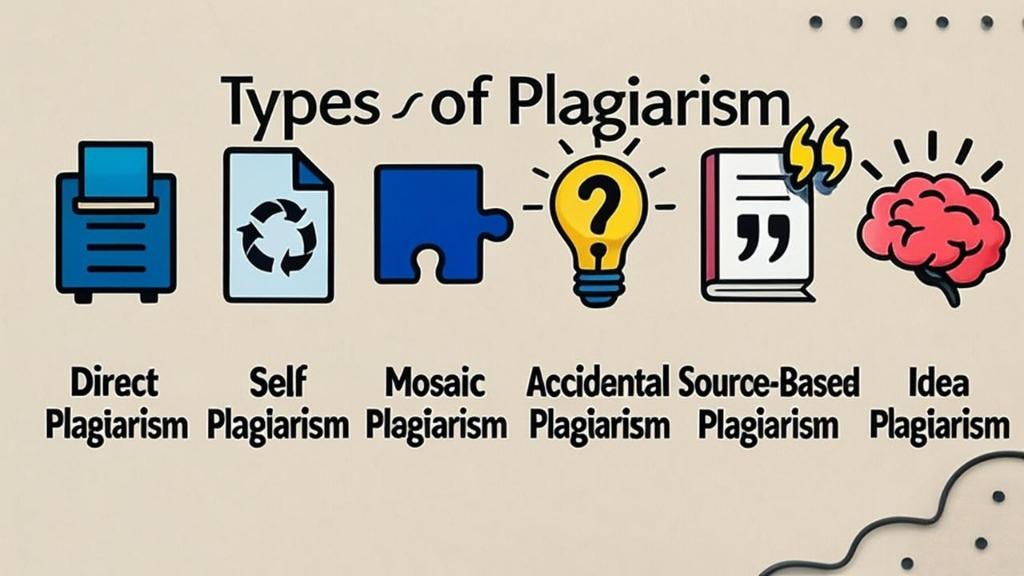Plagiarism: 10 things everyone should know about it

This is a very serious issue concerning all types of writers, researchers, students, and content developers in all genres. It is, therefore, very relevant how one grasps what is meant by the act of plagiarism and how to avoid the same so that by maintaining academic integrity and ethical sanctity through writing, the dignity of creative minds is upheld. Ten things that everyone needs to know about plagiarism are: .
Plagiarism is the use of words, ideas, or work of another person without mentioning that particular person's name. It may be copying verbatim text, paraphrasing without citation, or using a person's original idea without citing that particular thought.
Plagiarism Types

1.Direct Plagiarism
This is when a person plagiarizes others' work word-for-word. It ranges from the whole document to paragraphs, sentences, and even phrases.
2. Self-Plagiarism:
A case of self-plagiarism comes under a set of circumstances under which a person reuses bits and pieces from his earlier published work without proper citation or acknowledgment. This is somewhat not construed to be an act of dishonesty but may be misleading if proper disclosure is not made.
3.Mosaic Plagiarism
The term is used to mean patchwriting, where the user picks sentences or passages from the source document and partly paraphrases without proper citation. It is also hard to identify since there is partial copying from others' thoughts, yet it does not follow point to point.
4.Accidental Plagiarism
Word or phrasing of others without giving proper crediting. This takes place in cases when the note-taking is poor, citation improper, or there is a lack of knowledge on when and how to use sources of reference.
5 Poor Paraphrasing
A student can try rephrasing someone's ideas in their own words without changing the sentence structure or the words well enough to avoid plagiarism.
6.Verbatim Plagiarism
Verbatim plagiarism is copying someone's original work word-for-word without quotation or appropriate citation, and it would be similar to direct plagiarism. .
Consequences of Plagiarism
A charge of Plagiarism can be pretty serious in both academic and professional contexts. A student may end up failing their grades or, at worst, being suspended or even expelled from a particular institution. There may also be professional reputation and/or other legal repercussions at stake, especially when it involves copyright infringement.
How to avoid Plagiarism
Sources are appropriately cited to prevent plagiarism. Use quotation marks for direct quotations and provide the citation for paraphrased material. Know which citation style you need to use and apply it consistently across your paper. Proper source citation prevents plagiarism. Direct quotes need quotation marks. Paraphrased stuff needs citations, too. Figure out your required style — APA, MLA, whatever — and stick to it throughout. It's a game-changer for keeping your work legit and above board.
The institutions and the websites rely on various resources to detect plagiarism. Checkforplag Plagiarism Detection Software fights the existence of copied content by providing a way for instructors and website managers to ensure things are original.
Cultural views of plagiarism:
Cultural expectations of the acts of their members concerning plagiarism may differ, even vary, from culture to culture. There is a need to learn and appreciate such differences more so in globalized academic and research partnerships.
Fair Use and Copyright
All people must be adequately conversant with the basic rules of fair use and copyright laws. Fair use permits the use of copyrighted materials somewhat limitedly: you do not have to ask for H2: Fair Use and Copyright: All people must be adequately conversant with the basic rules of fair use and copyright laws. Fair use permits the use of copyrighted materials somewhat limitedly: you do not have to ask for permission when a copy is not a large fraction of the whole. This includes, but is not limited to, things such as criticism, comments, news, teaching, and research.
Educational Resources
Most schools have plagiarism prevention tools and classes based on the subject. These classes will help students or researchers to attribute and keep their work credit honest.
Ethical Issues
Plagiarism is not about rules or cheating in school but an issue dealing with right and wrong. The ethical concerns thematic all such moral issues related to research integrity, plagiarism, credit in authorship, conflict of interest, manipulation of data, and welfare of participants. The problems always beg for honesty, fairness, and respect for all persons involved. In brief, taking up ethical concerns confirms actions in both the academic and professional milieus through the stipulation of integrity and accountability, building trust and credibility in research, publication, and decision-making procedures.
Conclusion
Plagiarism is not about rules or cheating in school but an issue dealing with right and wrong. The ethical concerns thematic all such moral issues related to research integrity, plagiarism, credit in authorship, conflict of interest, manipulation of data, and welfare of participants. The problems always beg for honesty, fairness, and respect for all persons involved. In brief, taking up ethical concerns confirms actions in both the academic and professional milieus through the stipulation of integrity and accountability, building trust and credibility in research, publication, and decision-making procedures.
